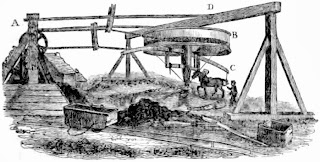Monday 23 December 2013
Saturday 21 December 2013
horse gin
In fact, animal domestication very often does involve the use of manual tools, but of
a kind we have not so far encountered. They are tools of coercion, such as the whip
or spur, designed to inflict physical force and very often acute pain (see Chapter Four,
p. 73). Another class of tools consists of those attached to the animals themselves and
operated as part of their performance. Thus the ‘handling’ of animals is really a two-stage
operation in which the human master, through the use of the instruments of coercion,
aims to control the skilled tool-using performance of his charges. Indeed there is an imme-
diate and obvious parallel here with slave-driving: like human slaves, similarly compelled
to work through the infliction of pain, animals constitute labour itself rather than its
instruments (Ingold 1980: 88).Friday 20 December 2013
wol
Labels:
animal architecture,
barriers,
feather,
invisibility,
owl,
pattern,
shadow,
zoo
Thursday 19 December 2013
Wednesday 18 December 2013
temari balls
http://www.flickr.com/photos/nanaakua/tags/temari/
how to
wikipedia/// Historically, temari were constructed from the remnants of old kimonos. Pieces of silk fabric would be wadded up to form a ball, and then the wad would be wrapped with strips of fabric. As time passed, traditional temari became an art, with the functional stitching becoming more decorative and detailed, until the balls displayed intricate embroidery. With the introduction of rubber to Japan, the balls went from play toys to art objects, although mothers still make them for their children. Temari became an art and craft of the Japanese upper class and aristocracy, and noble women competed in creating increasingly beautiful and intricate objects.
Temari are highly valued and cherished gifts, symbolizing deep friendship and loyalty. Also, the brilliant colors and threads used are symbolic of wishing the recipient a brilliant and happy life. Traditionally, becoming a craftsman in Japan was a tedious process. Becoming a temari artist in Japan today requires specific training, and one must be tested on one's skills and technique before being acknowledged as a crafter of temari.
Traditionally, temari were often given to children from their parents on New Year's Day. Inside the tightly wrapped layers of each ball, the mother would have placed a small piece of paper with a goodwill wish for her child. The child would never be told what wish his or her mother had made while making the ball.
Alternately, some balls contained "noisemakers" consisting of rice grains or bells to add to the play value. It is said that traditional temari were wrapped so tightly they would bounce.
London Charter
Paradata
Information about human processes of understanding and interpretation of data objects. Examples of paradata include descriptions stored within a structured dataset of how evidence was used to interpret an artefact, or a comment on methodological premises within a research publication. It is closely related, but somewhat different in emphasis, to "contextual metadata", which tend to communicate interpretations of an artefact or collection, rather than the process through which one or more artefacts were processed or interpreted.London Charter
Thursday 12 December 2013
fouquet // La pierre et le livre
Wednesday 11 December 2013
Taphonomy
Taphonomy is the study of decaying organisms over time and how they become fossilized (if they do). The term taphonomy (from the Greek taphos, τάφος meaning burial, and nomos, νόμος meaning law) was introduced to paleontology in 1940 by Russian scientist Ivan Efremov to describe the study of the transition of remains, parts, or products of organisms, from the biosphere, to the lithosphere, i.e. the creation of fossil assemblages.[1][2]
Oswalt’s techno-units
Tool complexity was quantified by the number of ‘techno-units’. A techno-unit was defined by Oswalt (1976, p. 38)
as ‘an integrated, physically distinct and unique structural
configuration that contributes to the form of a finished artefact’.
Techno-unit counts are based on verbal
descriptions, illustrations and photographs from the eHRAF and ranged
from one techno-unit
(e.g. a stick used for prying shellfish from the
reef) to 16 techno-units (e.g. an untended crab trap made of a bamboo
tube
and baited lever); see the electronic supplementary
material for an example of techno-unit coding. In contrast to Oswalt,
we include decorative elements in the techno-unit
counts because the production of any part of the tool may be socially
learned,
and thus subject to the dynamics of the cultural
transmission process upon which both models are based. If a given tool
was
present in more than one society's tool kit, we
coded that tool independently for each society where information was
available.
Next, we computed the mean of these techno-unit
estimates. We then used the mean as the techno-unit estimate for that
tool
across all societies where it was present,
replacing the original independent estimates. This helped to control for
potential
coder and/or ethnographer bias and worked against
our hypotheses by decreasing variation between groups.
http://rspb.royalsocietypublishing.org/content/early/2010/04/08/rspb.2010.0452.full
http://rspb.royalsocietypublishing.org/content/early/2010/04/08/rspb.2010.0452.full
Measuring Lithic Technology Complexity
Jump To Section...
We
define technological complexity as the minimum amount of information
that is needed to manufacture a product. This definition is in line with
other formalized definitions of complexity (Shannon and Weaver 1949).
Computer scientists, for example, have defined the complexity of an
algorithm as the shortest string length, or the smallest number of bits
of information, that is necessary to describe it (Chaitin 1970).
This information criterion is analogous to the various measures of
richness used to describe biological systems that are defined as the
number of unique types of some constituent present within an aggregate
group. For instance, at the level of the organism, biological complexity
has been measured as the count of cell types (Bonner 1988). At the level of an ecosystem, biological complexity has been measured as the count of unique species it contains (Bonner 1988).
Finally, the complexity of animal behavior has also been estimated by
counting the number of elemental “building blocks” that is associated
with a specific behavior or, at a larger scale, as the number of acts in
a species’ behavioral repertoire (Sambrook and Whiten 1997; Whiten et al. 1999).
In
the same spirit, we argue that the complexity of a technology can be
measured by counting the number of elemental building blocks associated
with it. We call these building blocks “procedural units.” We define
procedural units as mutually exclusive manufacturing steps that make a
distinct contribution to the finished form of the product of a
technology. Focusing on lithic technology, the count of procedural units
present in a tool reduction sequence is a measure of complexity because
it reflects the minimum amount of information that is needed to carry
it out to a successful end.
This procedural-unit approach to stone-tool complexity parallels Oswalt’s “techno-units” (Oswalt 1976).
Oswalt assessed the complexity of food-getting technologies by counting
(1) the number of tool types present in a tool kit, which he called
“subsistants,” and (2) the number of integrated and physically distinct
structures that contribute to the finished form of a tool, which he
called “techno-units.” Oswalt’s method is powerful because it allows for
the measurement of technological complexity cross-culturally. It has
been applied to ethnographic data to test a wide range of hypotheses,
including hypotheses about the ecological determinants of technological
complexity (Collard, Kemery, and Banks 2005; Collard et al. 2011; Shott 1986; Torrence 1983, 1989, 2000) and the effect of demography on the evolution of technologies (Collard, Kemery, and Banks 2005; Collard et al. 2011; Kline and Boyd 2010; Oswalt 1976).
Measuring the Complexity of Lithic Technology
Charles Perreault, P. Jeffrey Brantingham, Steven L. Kuhn, Sarah Wurz, and Xing GaoSunday 8 December 2013
Wednesday 4 December 2013
common conduct
Research
Photography
Show
2013
RCA
Criodhna Costello
Jessica Potter
Francis Summers
Private View:
Friday 6th December
18.30-20.30
Open:
Thursday 5th to Monday 9th
(closed Sunday 8th)
12.00-16.00
Dyson Gallery
Royal College of Art
1 Hester Road
London SW11 4AN
Saturday 30 November 2013
allagmatic
The Greek word allagma can mean change or vicissitude, but it can also mean that which can be given or taken in exchange.
allagmatic - theory of operations chaine operatoire
operation - a conversion of a structure into another structure
“The true principle of individuation can neither be sought in what exists before the individuation occurs, nor in what remains after the individuation is accomplished; it is the system of energy that is individuating insofar as it realizes in the individual this internal resonance of the matter taking form and a mediation between orders of magnitude. The principle of individuation is the single way in which the internal resonance of this matter is established taking this form. The principle of individuation is an operation. With the result that a being is itself, different from all the others; it is neither its matter nor its form, but it is the operation by which its matter took form in a certain system of internal resonance. The principle of individuation of brick is not the clay, nor the mold: this heap of clay and this mold will leave other bricks than this one, each one having its own haecceity, but it is the operation by which the clay, at a given time, in an energy system which included the finest details of the mold as the smallest components of this wet dirt took form, under such pressure, thus left again, thus diffused, thus self-actualized: a moment ago when the energy was thoroughly transmitted in all directions from each molecule to all the others, from the clay to the walls and the walls to the clay: the principle of individuation is the operation that carries out an energy exchange between the matter and the form, until the unity leads to a state of equilibrium. One could say that the principle of individuation is the common allagmatic operation of the matter and form through the actualization of potential energy. This energy is energy of a system; it can produce effects in all the points of the system in an equal way, it is available and is communicated. This operation rests on the singularity or the singularities of the concrete here and now; it envelops them and amplifies them” L’individu et sa genese physico-biologique, simondon
allagmatic - theory of operations chaine operatoire
operation - a conversion of a structure into another structure
“The true principle of individuation can neither be sought in what exists before the individuation occurs, nor in what remains after the individuation is accomplished; it is the system of energy that is individuating insofar as it realizes in the individual this internal resonance of the matter taking form and a mediation between orders of magnitude. The principle of individuation is the single way in which the internal resonance of this matter is established taking this form. The principle of individuation is an operation. With the result that a being is itself, different from all the others; it is neither its matter nor its form, but it is the operation by which its matter took form in a certain system of internal resonance. The principle of individuation of brick is not the clay, nor the mold: this heap of clay and this mold will leave other bricks than this one, each one having its own haecceity, but it is the operation by which the clay, at a given time, in an energy system which included the finest details of the mold as the smallest components of this wet dirt took form, under such pressure, thus left again, thus diffused, thus self-actualized: a moment ago when the energy was thoroughly transmitted in all directions from each molecule to all the others, from the clay to the walls and the walls to the clay: the principle of individuation is the operation that carries out an energy exchange between the matter and the form, until the unity leads to a state of equilibrium. One could say that the principle of individuation is the common allagmatic operation of the matter and form through the actualization of potential energy. This energy is energy of a system; it can produce effects in all the points of the system in an equal way, it is available and is communicated. This operation rests on the singularity or the singularities of the concrete here and now; it envelops them and amplifies them” L’individu et sa genese physico-biologique, simondon
...explicitly
to the manual creation of a material culture that is extracorporal. Gesture
paralleled speech as a form of expression of mind and language. This notion of
ges ture is closely linked to a key theoretical and methodological concept,
that of the chaine operatoire, or "operational sequence." Leroi-Gourhan makes it clear
that apart from humans the behavior of many animals is characterized by such
deeply embedded operational sequences. But only with humans do we see these
operational sequences
take material form and become more-or-Iess permanent constituents of the
human environment.
For Leroi-Gourhan such operational
sequences constitute the building blocks of technology, indeed of culture. They
are culturally or ethnically conditioned and highly structured but through
repetition and conditioning at a young age become more-or-Iess subconscious.
Whether these operational sequences structure the fabrication of stone tools,
the manufacture of personal ornaments, or the creation of painted and engraved
underground sanctuaries, they are the focus of analysis. For archaeologists
they represent an accessible entry to social organization and cosmology. But
these operational sequences often remain unverbalized and unrecognized by
those who practice them. That is why Leroi-Gourhan can claim
to have recognized basic binary oppositions in the
organization/structure of painted caves while explicitly stating that the
meaning of specific images remains unknown and probably unknowable.
Because
operational sequences are culturally/ethnically derived, they are the
fundamental basis for what ethnologists, archaeologists, and art historians
recognize as "style":
The technical life of the hunter, and
later of the farmer and the artisan, involves a large number of sequences that
correspond to the many actions needed for their material survival. These
sequences are empir ical, borrowed from a collective tradition that one
generation passes down to the next. Their principal trait, for all the unity of
their broad out lines and their extension over vast polyethnic territories, is
their strongly marked local and individual character. (infra:
253)
...
It rendered possible the
externalization of memory and hence mythological narrative.
Figurative
behavior cannot be dissociated from language: It forms part of the same human
aptitude, that of reflecting reality in verbal or gestural symbols or in
material form as figures.Just as the emergence of language is connected with
that of hand tools, figurative representation cannot be separated from the common source from which all making and
all rep resentation spring. Therefore we should not be surprised to discover a
close parallelism in paleontological development and, in particular, to note a swift and profound change in materials
at the moment Homo sa
piens emerges
from the last Palaeoanthropian stage. (infra: 363)
The whole of our evolution has been
oriented toward placing outside ourselves what in the rest of the animal world
is achieved inside by
spe cies adaptation. The most striking material fact is certainly the
"freeing" of tools, but the fundamental fact is really the freeing of
the word and our unique ability to transfer our memory to a social organism
outside our selves. (infra: 235)
Leroi-Gourhan// Gesture & Speech
Thursday 28 November 2013
Saturday 9 November 2013
oddball paleontology /// carved stone balls
the systematic description of a discourse object... 139
the system of transformations that constitute change 173
it does not have a unifying, but a diversifying effect 160
baetyl (plural baetyls)
- (Antiquity) a meteorite or similar-looking rough stone thought to be of divine origin and worshipped as sacred.
pole lathe
bow drill
potter's wheel
Thursday 7 November 2013
khipu / quipu
"It matters what matters we use to
think other matters with; it matters what stories we tell to tell other
stories with; it matters what knots knot knots, what thoughts think
thoughts, what ties tie ties. It matters what stories make worlds, what
worlds make stories.” (Haraway 2011: 4)
Subscribe to:
Posts (Atom)


































